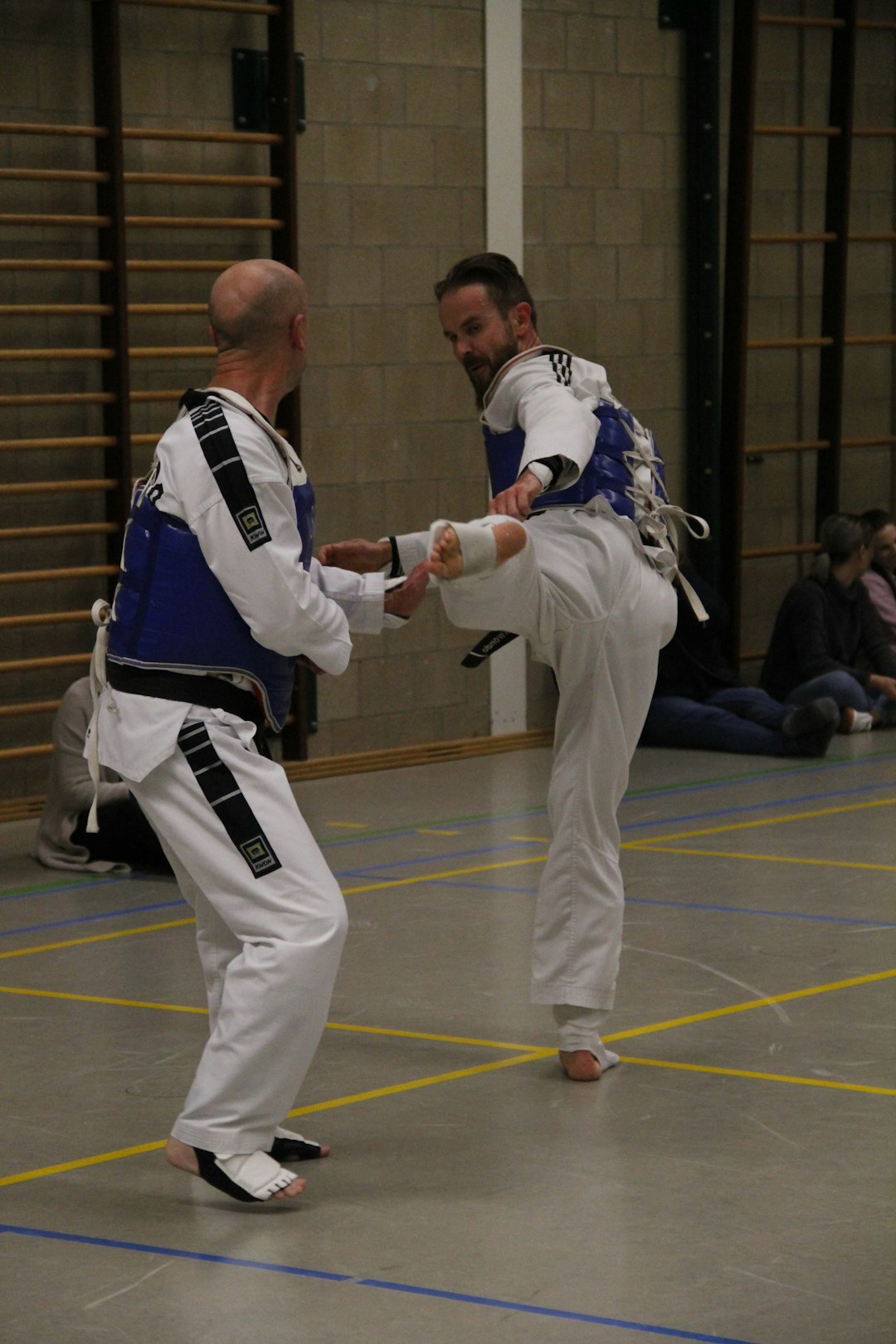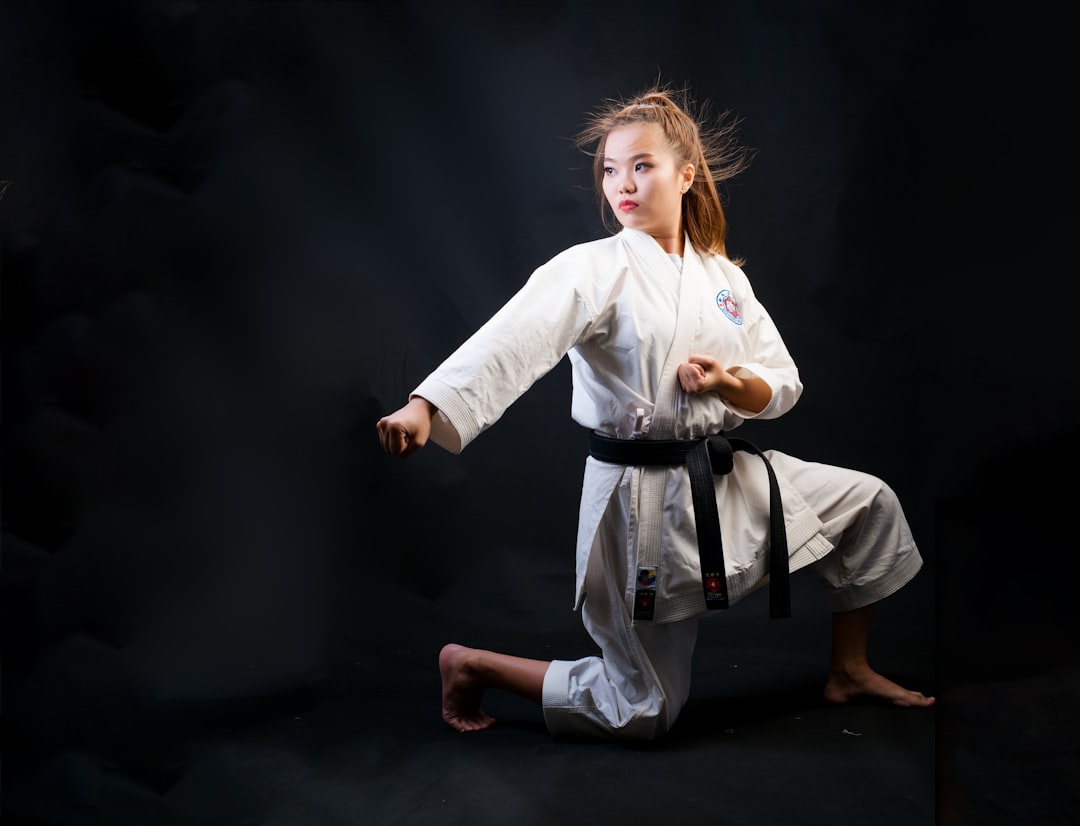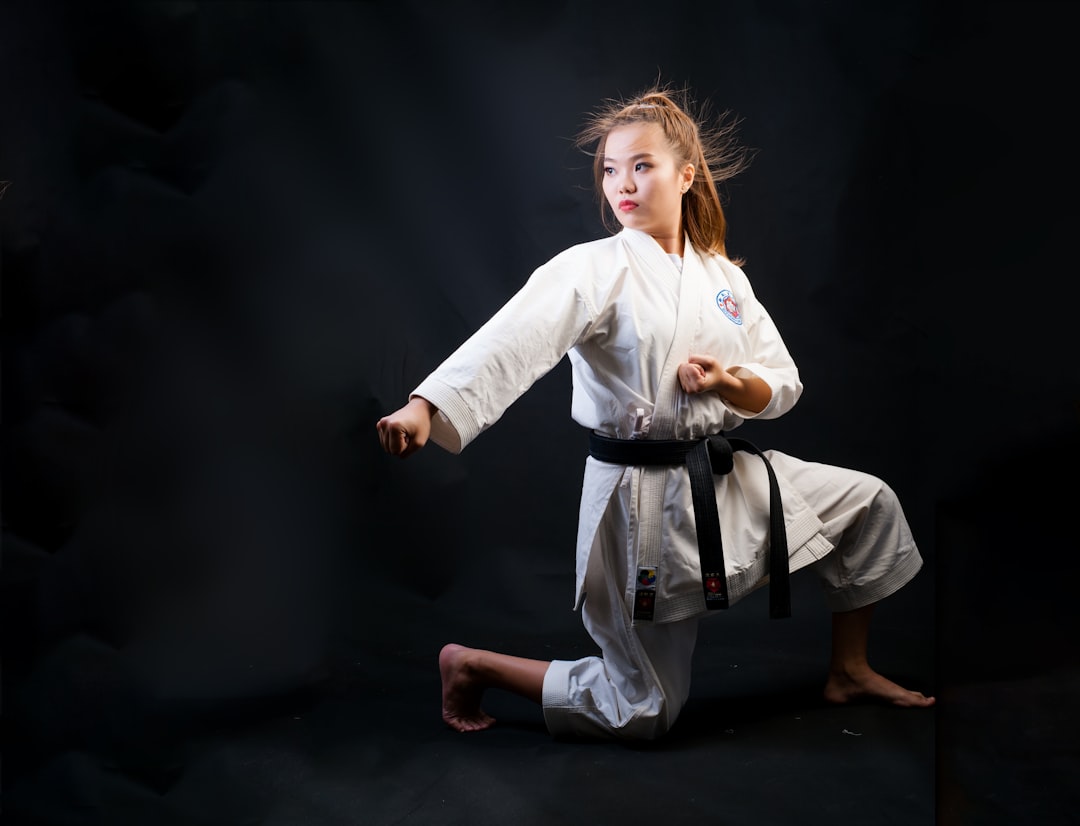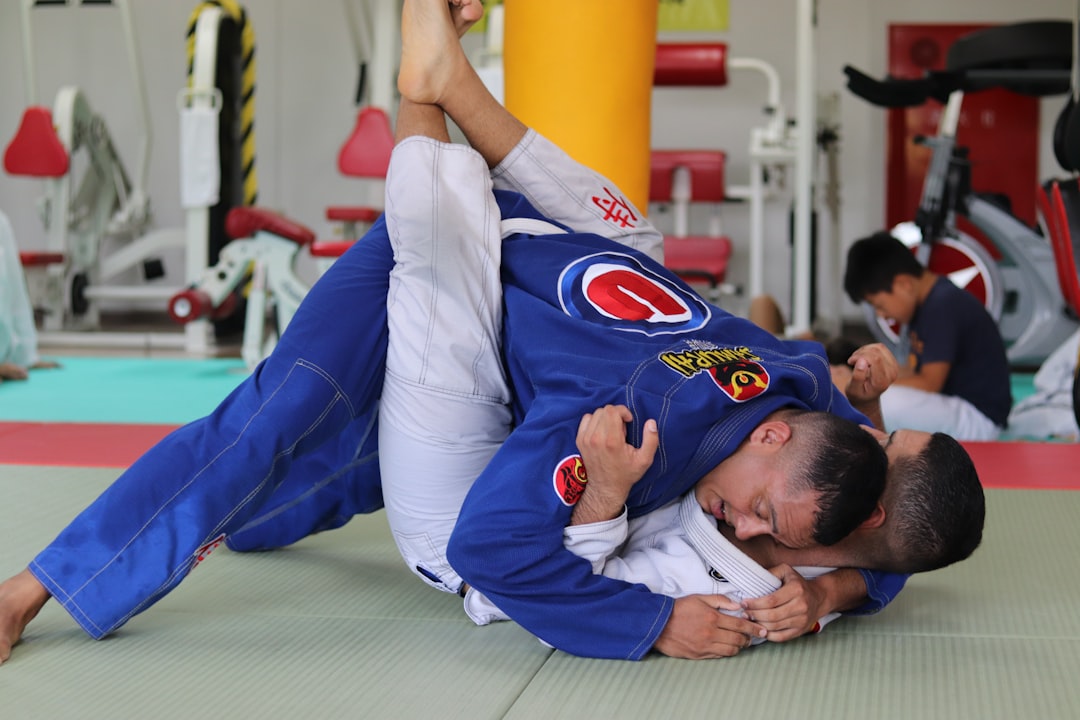The karate suit, or keikogi, is central to the practice of martial arts, serving as a uniform that enhances movement, protects against injury, and promotes equality among practitioners. Originating from Japan, the keikogi's design has evolved over time to meet the functional needs of karateka, closely resembling the judo keikogi but with adaptations for optimal mobility in high kicks and complex maneuvers. It consists of a jacket, trousers, and an obi belt that denotes rank, and can be complemented with a hakama for advanced practitioners. Selecting the right keikogi is crucial for performance; it should fit perfectly to allow full range of motion and be made from durable, breathable materials like cotton or polyester blends. Regular cleaning is necessary for hygiene and longevity. Additionally, protective and supportive wear beneath the suit, along with mouthguards and appropriate footwear, can further enhance safety and comfort during training. The karate belt not only secures the gi but also indicates the practitioner's level of skill. Overall, the keikogi is more than a garment; it is an integral aspect of karate discipline, symbolizing respect and integrity in the martial art.
Karate enthusiasts often inquire about the specific attire that defines their practice. Known commonly as a “karate suit,” this garment is central to the discipline, offering more than just a uniform appearance. This article delves into the essential aspects of the karate suit, tracing its historical evolution, dissecting its components and construction for insight into its design, and guiding on how to select the ideal gi for training. Additionally, we explore tips for maintaining your suit and accessories that can enhance performance during practice. Understanding the karate suit’s role extends beyond mere awareness; it encompasses the tradition and respect inherent in this martial art form.
- Understanding the Karate Suit: Essential Attire for Martial Artists
- The Evolution of the Karate Gi: A Historical Perspective
- Components and Construction: Breaking Down the Karate Suit
- Selecting the Perfect Karate Suit: Size, Material, and Maintenance
- Training Gear: Accessorizing Your Karate Gi for Optimal Performance
Understanding the Karate Suit: Essential Attire for Martial Artists

When delving into the realm of martial arts, one encounters various pieces of equipment that are integral to the practice, and among these is the karate suit, a garment that not only facilitates the execution of techniques but also signifies respect for the discipline. Often referred to as “keikogi” or “gi” in Japanese, this attire is specifically designed for martial arts training. Is the karate suit simply a uniform, or does it serve a more significant role within the practice? The keikogi is engineered with specific features to accommodate the movements intrinsic to karate practices. It is tailored to be comfortable yet durable, allowing for a full range of motion without restricting the practitioner during sparring or kata performance. What purpose does the karate suit serve beyond its immediate appearance? The suit serves as a protective layer that minimizes the risk of injury from strikes and throws while still being lightweight enough to not impede the wearer’s agility or flexibility. Additionally, it is constructed with a uniformity that fosters a sense of equality among practitioners, emphasizing skill over material advantage. Whether for casual training, competition, or formal demonstration, the karate suit is an essential piece of equipment for any serious martial artist.
The Evolution of the Karate Gi: A Historical Perspective

The evolution of the karate gi, commonly referred to as a karate suit, is deeply rooted in Japanese history and tradition. Originally, practitioners of martial arts did not wear uniforms; instead, they trained in their daily attire. However, as Okinawan karate began to formalize in the early 20th century, it became necessary for students to have a distinctive outfit that would facilitate training and help identify practitioners. The modern karate gi, with its white cotton fabric, was influenced by the traditional Japanese judo uniform. It features a jacket and trousers, often accompanied by a belt, or obi, which signifies the wearer’s rank. Over time, the design of the gi has undergone subtle changes to better accommodate the needs of karateka, as they are called, during practice and competition. What materials were used historically for the karate suit called? Initially, heavier materials such as hemp or cotton were utilized due to their durability and availability in Okinawa. As the art spread globally, the gi’s design and fabric also evolved to cater to various climates and training conditions, with lighter fabrics becoming more common for summer training and heavier ones for colder environments.
Components and Construction: Breaking Down the Karate Suit

When delving into the specifics of a karate suit, commonly referred to as a “keikogi” in Japanese, one must understand its components and construction to appreciate its purpose and design. The keikogi is distinct from other martial arts uniforms, tailored specifically for the demands of karate practice. It consists of a jacket, trousers, and a belt, each serving a unique function and contributing to the practitioner’s mobility and comfort during training.
The jacket, known as “uwagi,” is cut longer at the back than at the front to allow for a full range of motion, particularly important for the high kicks and dynamic movements characteristic of karate. It is typically made from heavier cotton fabric, providing durability while allowing for ease of movement. The trousers, or “nakadi,” are straight-legged and also constructed with movement in mind, featuring a side split to facilitate flexibility. Both the jacket and trousers are designed without belts or adornments that could catch on an opponent during sparring. The belt, or “obiwari,” is separate from the suit and serves to hold the garment closed; it is tied at the waist and can be secured with a “hakama” for higher ranks, which is a divided skirt providing additional mobility and a traditional aesthetic. What differentiates the keikogi from other martial arts attire is its emphasis on functionality, ensuring that every stitch contributes to the practitioner’s performance in their discipline.
Selecting the Perfect Karate Suit: Size, Material, and Maintenance

When selecting the perfect karate suit, known as a “keikogi” in Japanese, it’s crucial to consider the size and fit, as this will significantly impact your mobility and comfort during practice or competition. A well-fitting keikogi should allow for a full range of motion, enabling you to execute techniques with ease. The suit should not be too tight, restricting movement, nor too loose, which could cause the garment to catch on something or become a tripping hazard. It’s also important to choose a material that suits your needs; cotton and polyester blends are common choices due to their durability and breathability, wicking away sweat and providing comfort over extended training sessions. Additionally, consider the maintenance of your keikogi. Opt for machine-washable fabrics if you prefer convenience, or select a material that can be hand-washed for a gentler approach, especially if you have sensitive skin or are allergic to certain detergents or fabric softeners. Regular cleaning is essential to maintain the suit’s condition and hygiene, ensuring it lasts as long as possible. Does the keikogi you choose feel restrictive or allow for a full range of motion necessary for karate techniques? Is the material breathable and suitable for your personal comfort and any sensitivities you may have? Ensuring these aspects are addressed will help you select the perfect karate suit for your practice.
Training Gear: Accessorizing Your Karate Gi for Optimal Performance

When preparing for a karate training session, the attire you choose can significantly impact your performance. A karate suit, commonly referred to as a “gi,” is more than just a traditional uniform; it’s an integral part of a martial artist’s regimen. The gi not only signifies discipline and respect for the art but also offers practical benefits in terms of mobility and comfort during practice. To optimize your training experience, consider what goes under the gi as well. Are compression shorts or leggings suitable for your training? They can provide support and reduce muscle vibration during high-intensity movements. Do you require additional padding for protection during sparring sessions? Gear like shin guards and groin protectors are essential for safety, especially when practicing with a partner. Additionally, a well-fitted mouthguard is crucial to safeguard your teeth and gums from accidents that can occur unexpectedly.
Choosing the right accessories to complement your karate gi is key to ensuring both your comfort and safety while training. Are the grips on your hands causing discomfort? Consider using hand wraps or grippy gloves to alleviate this issue without hindering your grip on your opponent. Is the impact of kicks resonating through your feet? Impact-resistant footwear can help mitigate these effects, allowing you to train harder and longer. Furthermore, a karate belt, or obi, not only holds your gi closed but also indicates your rank within the discipline. Ensure that your belt is tied correctly for proper presentation during practice and competition. Remember, the goal is to wear gear that allows you to focus on perfecting your techniques without distraction from discomfort or safety concerns. What accessories do you use to enhance your training? The answer may vary depending on personal preference and the specific style of karate you practice. Always prioritize functionality and comfort when selecting additional gear to accompany your karate suit, known as a gi.
In conclusion, the karate suit, known as a ‘keikogi’ or ‘gi,’ is more than mere attire; it represents tradition and functionality in the discipline of karate. From its historical origins to the modern iterations that cater to the needs of practitioners, understanding the components and construction of a karate gi is crucial for selecting the perfect one, considering size, material, and maintenance. Whether you are an aspiring martial artist or a seasoned practitioner, outfitting yourself with a suitable karate suit is essential for performance and respect for the art. Properly accessorizing your gi can enhance your training experience, ensuring that you are well-equipped to face the challenges of karate with the right gear. Remember, the true essence of karate is not just in the movements or techniques, but also in the attire that accompanies the practice, symbolizing respect for the tradition and commitment to the craft.
